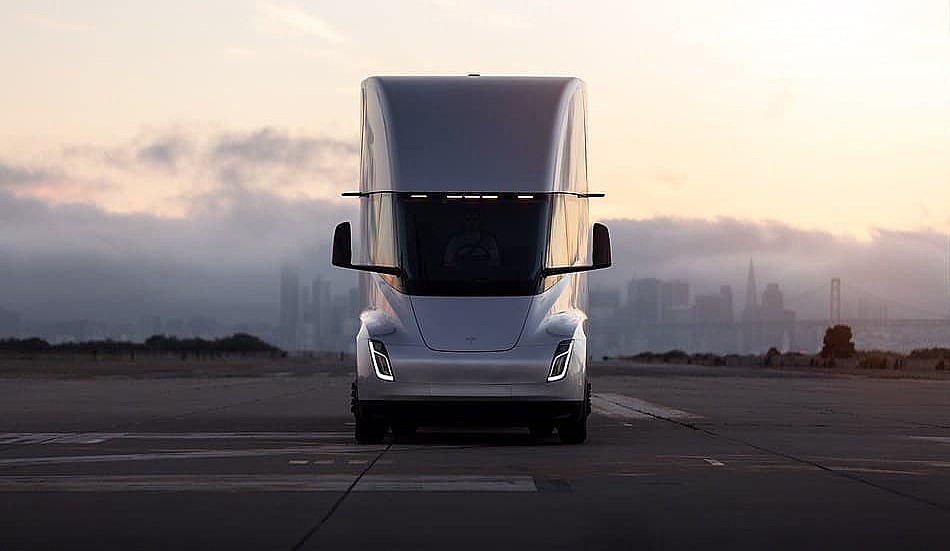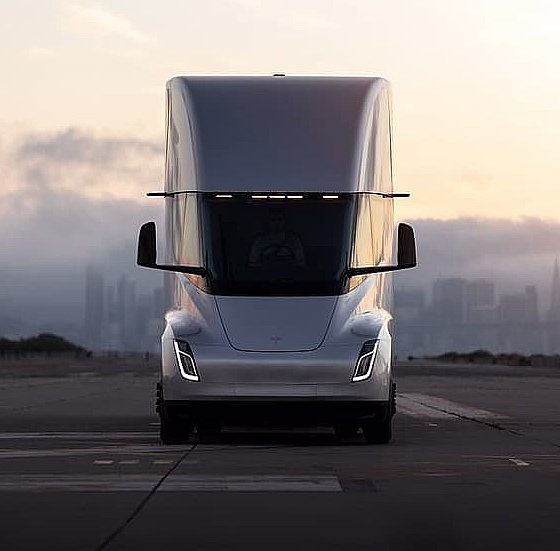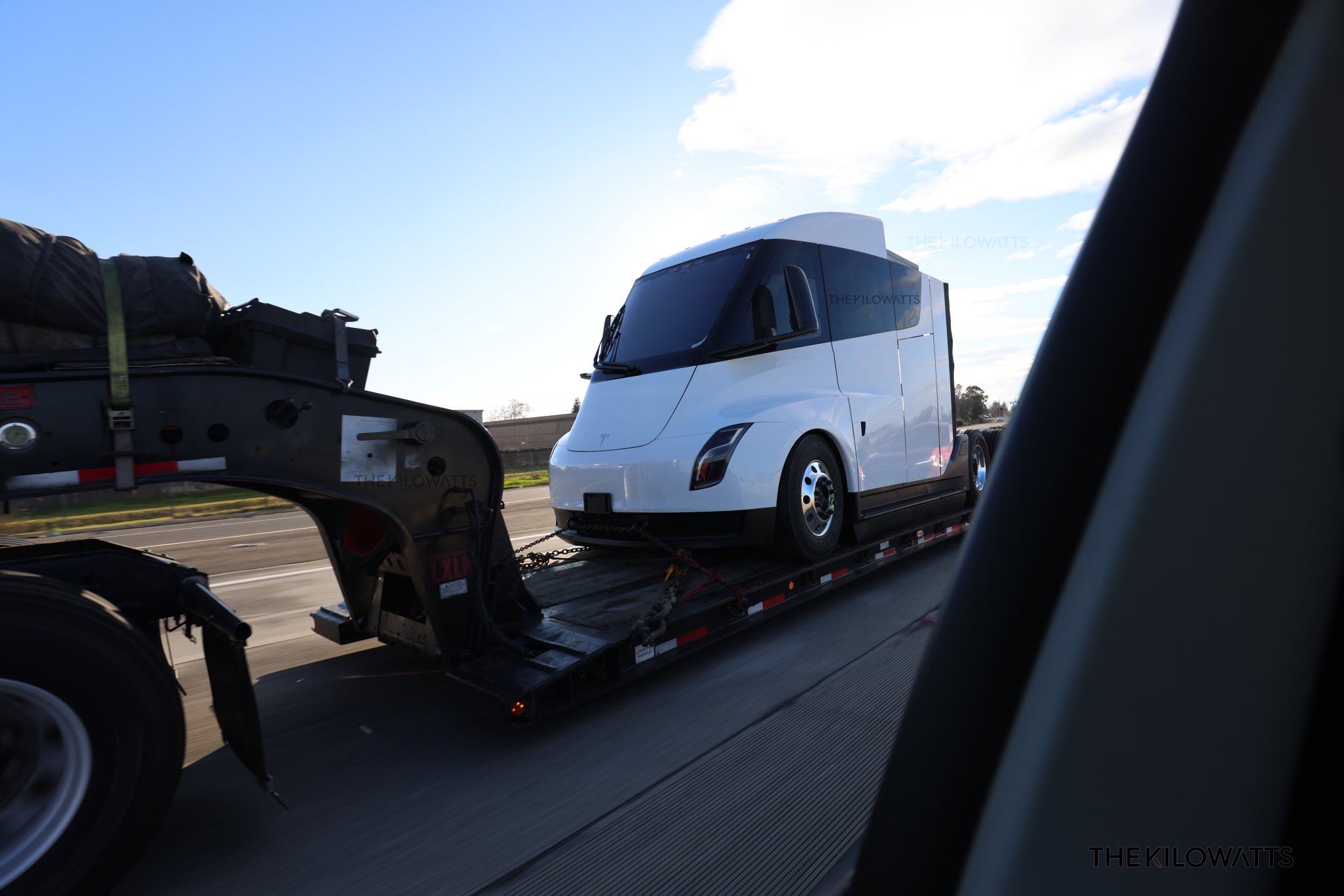

News
The Tesla Semi’s 500 kWh battery and Convoy Mode are grossly underestimated
The Tesla Semi may be delayed for quite some time now, but it appears that Elon Musk’s all-electric Class 8 truck will be well worth the wait. And as the upcoming truck gets closer to mass production, it is becoming more and more evident that the Semi’s potential—particularly with regards to its batteries and FSD features—remains grossly underestimated.
During a recent appearance at the Joe Rogan Experience podcast, Elon Musk revealed that the Semi would be equipped with a 500 kWh battery pack. The Tesla CEO did not specify which variant of the Semi will be fitted with a 500 kWh pack, though speculations from the electric vehicle community suggest that the battery would be for the truck’s 300-mile variant. However, even if this were the case, such an update provides a glimpse at just how far Tesla has come when it comes to its battery technology.

“You want something in the order of probably a 500 kWh pack. What we have in the Model S and X is a 100 kWh pack and probably something like a 500 kWh pack in the Tesla Semi,” Musk said.
When the Semi was unveiled in late 2017, Tesla noted that the vehicle would consume less than 2 kWh per mile. Considering that the Tesla Semi’s two variants are listed with 300 and 500 miles of range, estimates pointed to the vehicle having a battery pack that’s likely around 600 kWh to 1,000 kWh. Musk’s recent update suggests that Tesla has improved its batteries to such a degree that the Semi now needs a smaller battery pack to accomplish its 300-mile range target. This may seem like a minor change, but a smaller battery pack presents numerous advantages, such as lower weight and significant production cost savings. These all contribute to make the 300-mile Tesla Semi a viable and competitive vehicle, especially considering its estimated $150,000 base price.
Of course, these advantages only become more prominent if one considers the benefits of Tesla’s structural 4680 battery packs. With structural batteries in place, the Semi could save weight and production costs even further. A structural battery could also make the Semi more rigid, allowing it to be even safer than its initial iterations. This goes hand in hand with another update on the vehicle that was mentioned by Tesla, and one that is also widely ignored or at most underestimated today.

During Tesla’s Q4 FY 2020 earnings call, Elon Musk confirmed that the Semi might very well be the first vehicle in the company’s lineup that would receive full autonomy features. This was a point highlighted by both Elon Musk and Automotive President Jerome Guillen, who noted that the FSD hardware on the Semi would be the same one used in Tesla’s other vehicles. Musk, for his part, pointed out that the Semi’s FSD features will require Tesla to modify the FSD software’s parameters according to the Semi’s large size.
Perhaps one thing that is rarely mentioned is that when the Semi was unveiled in 2017, Elon Musk remarked that the vehicle was already capable of utilizing a feature called “Convoy Mode,” which optimizes efficiency while allowing several uncrewed trucks to follow a lead, crewed vehicle. If Musk’s statements were accurate and Convoy Mode was already feasible with Enhanced Autopilot’s capabilities in late 2017, then such a function would likely be extremely plausible today with the Full Self-Driving Beta. This should make the Semi safer to use than traditional long-haulers, most of whom are still manually driven. Couple this with the Semi’s functions like its four electric motors, which help prevent incidents like jackknifing, and the upcoming all-electric Class 8 truck has a shot at becoming one of the safest large vehicles on the road today.
Don’t hesitate to contact us for news tips. Just send a message to tips@teslarati.com to give us a heads up.

News
Tesla FSD fleet is nearing 7 billion total miles, including 2.5 billion city miles
As can be seen on Tesla’s official FSD webpage, vehicles equipped with the system have now navigated over 6.99 billion miles.

Tesla’s Full Self-Driving (Supervised) fleet is closing in on almost 7 billion total miles driven, as per data posted by the company on its official FSD webpage.
These figures hint at the massive scale of data fueling Tesla’s rapid FSD improvements, which have been quite notable as of late.
FSD mileage milestones
As can be seen on Tesla’s official FSD webpage, vehicles equipped with the system have now navigated over 6.99 billion miles. Tesla owner and avid FSD tester Whole Mars Catalog also shared a screenshot indicating that from the nearly 7 billion miles traveled by the FSD fleet, more than 2.5 billion miles were driven inside cities.
City miles are particularly valuable for complex urban scenarios like unprotected turns, pedestrian interactions, and traffic lights. This is also the difference-maker for FSD, as only complex solutions, such as Waymo’s self-driving taxis, operate similarly on inner-city streets. And even then, incidents such as the San Francisco blackouts have proven challenging for sensor-rich vehicles like Waymos.
Tesla’s data edge
Tesla has a number of advantages in the autonomous vehicle sector, one of which is the size of its fleet and the number of vehicles training FSD on real-world roads. Tesla’s nearly 7 billion FSD miles then allow the company to roll out updates that make its vehicles behave like they are being driven by experienced drivers, even if they are operating on their own.
So notable are Tesla’s improvements to FSD that NVIDIA Director of Robotics Jim Fan, after experiencing FSD v14, noted that the system is the first AI that passes what he described as a “Physical Turing Test.”
“Despite knowing exactly how robot learning works, I still find it magical watching the steering wheel turn by itself. First it feels surreal, next it becomes routine. Then, like the smartphone, taking it away actively hurts. This is how humanity gets rewired and glued to god-like technologies,” Fan wrote in a post on X.
News
Tesla starts showing how FSD will change lives in Europe
Local officials tested the system on narrow country roads and were impressed by FSD’s smooth, human-like driving, with some calling the service a game-changer for everyday life in areas that are far from urban centers.

Tesla has launched Europe’s first public shuttle service using Full Self-Driving (Supervised) in the rural Eifelkreis Bitburg-Prüm region of Germany, demonstrating how the technology can restore independence and mobility for people who struggle with limited transport options.
Local officials tested the system on narrow country roads and were impressed by FSD’s smooth, human-like driving, with some calling the service a game-changer for everyday life in areas that are far from urban centers.
Officials see real impact on rural residents
Arzfeld Mayor Johannes Kuhl and District Administrator Andreas Kruppert personally tested the Tesla shuttle service. This allowed them to see just how well FSD navigated winding lanes and rural roads confidently. Kruppert said, “Autonomous driving sounds like science fiction to many, but we simply see here that it works totally well in rural regions too.” Kuhl, for his part, also noted that FSD “feels like a very experienced driver.”
The pilot complements the area’s “Citizen Bus” program, which provides on-demand rides for elderly residents who can no longer drive themselves. Tesla Europe shared a video of a demonstration of the service, highlighting how FSD gives people their freedom back, even in places where public transport is not as prevalent.
What the Ministry for Economic Affairs and Transport says
Rhineland-Palatinate’s Minister Daniela Schmitt supported the project, praising the collaboration that made this “first of its kind in Europe” possible. As per the ministry, the rural rollout for the service shows FSD’s potential beyond major cities, and it delivers tangible benefits like grocery runs, doctor visits, and social connections for isolated residents.
“Reliable and flexible mobility is especially vital in rural areas. With the launch of a shuttle service using self-driving vehicles (FSD supervised) by Tesla in the Eifelkreis Bitburg-Prüm, an innovative pilot project is now getting underway that complements local community bus services. It is the first project of its kind in Europe.
“The result is a real gain for rural mobility: greater accessibility, more flexibility and tangible benefits for everyday life. A strong signal for innovation, cooperation and future-oriented mobility beyond urban centers,” the ministry wrote in a LinkedIn post.
News
Tesla China quietly posts Robotaxi-related job listing
Tesla China is currently seeking a Low Voltage Electrical Engineer to work on circuit board design for the company’s autonomous vehicles.

Tesla has posted a new job listing in Shanghai explicitly tied to its Robotaxi program, fueling speculation that the company is preparing to launch its dedicated autonomous ride-hailing service in China.
As noted in the listing, Tesla China is currently seeking a Low Voltage Electrical Engineer to work on circuit board design for the company’s autonomous vehicles.
Robotaxi-specific role
The listing, which was shared on social media platform X by industry watcher @tslaming, suggested that Tesla China is looking to fill the role urgently. The job listing itself specifically mentions that the person hired for the role will be working on the Low Voltage Hardware team, which would design the circuit boards that would serve as the nervous system of the Robotaxi.
Key tasks for the role, as indicated in the job listing, include collaboration with PCB layout, firmware, mechanical, program management, and validation teams, among other responsibilities. The role is based in Shanghai.
China Robotaxi launch
China represents a massive potential market for robotaxis, with its dense urban centers and supportive policies in select cities. Tesla has limited permission to roll out FSD in the country, though despite this, its vehicles have been hailed as among the best in the market when it comes to autonomous features. So far, at least, it appears that China supports Tesla’s FSD and Robotaxi rollout.
This was hinted at in November, when Tesla brought the Cybercab to the 8th China International Import Expo (CIIE) in Shanghai, marking the first time that the autonomous two-seater was brought to the Asia-Pacific region. The vehicle, despite not having a release date in China, received a significant amount of interest among the event’s attendees.








